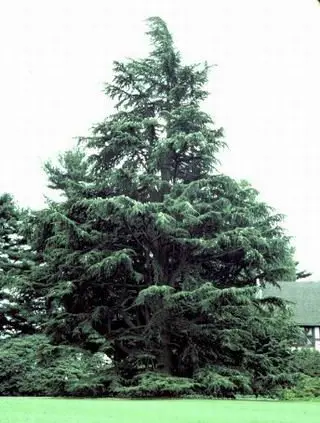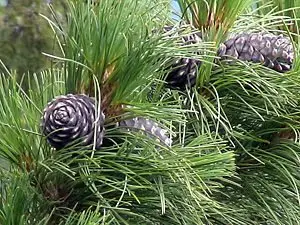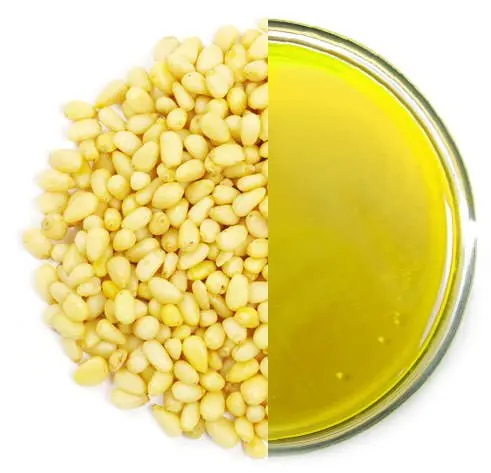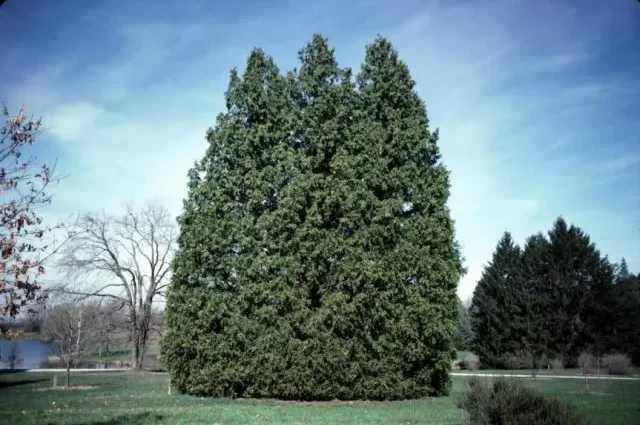Contents
- Useful properties and application of cedar
- Botanical characteristics of Siberian cedar
- Useful properties of cedar
- The use of cedar
- Hive (cedar resin)
- Recipes for making balms and tinctures
- Planting a cedar
- Essential oil of cedar
- Siberian cedar
- Cedar Himalayan
- Cedar Atlas
- Recipes for baths and compresses with oil:
- “Golden Cedar”
- cedar leaves
- Cedar fruits
- Pine nut shell recipes
- Contraindications to the use of cedar
Useful properties and application of cedar
Botanical characteristics of Siberian cedar

Siberian cedar – coniferous evergreen, famous for its incredible height. Its average height is about 25 m, but there are often representatives whose height reaches 40-50 meters.
Cedar is a beautiful, slender tree that loves sunlight. The plant belongs to the pine family and is the oldest representative of its kind (about 100 million years).
Cedar is a pine long-liver: it is believed that its age can reach 400 years, but on average cedars live from 200 to 250 years. It is worth noting that in extremely favorable conditions, a tree can live up to 800 years.
The trunk of the tree is slender, bare below, begins to branch at a height of approximately 1,5–2 m from ground level. The bark of a young tree is smooth, brown-gray. In adult representatives, the bark is cracked, brown-red or grayish in color.
The bark is very thin, it poorly protects the trunk from various kinds of damage, as well as from the penetration of infections caused by fungi.
The needles are needle-shaped, long, trihedral, soft, there are 5 needles in one bundle. The life span of needles is 9–11 years. The special structure of the needles allows the tree to retain moisture as much as possible due to the possibility of its minimal evaporation.
Cedar pine is a tree on which both female and male individuals develop simultaneously.
Female cones are characterized by a purple hue, they appear 2-5 pieces on the terminal shoots of well-lit branches (at the very top).
Male spikelets are formed on the lateral shoots of branches located in the middle part of the crown.
Under conditions of good sunlight penetration, male spikelets and female cones can form on the same branch.
In June, pollination occurs, after 11-12 months (from the moment of pollination) – fertilization.
Seed ripening occurs in September of the following year after pollination. Due to the presence of special air sacs, pollen easily scatters over long distances. It should be noted that the vegetative and reproductive organs of the cedar are not afraid of low temperatures. However, “flowers” and female cones, on the contrary, are very sensitive to temperature changes. They can hardly endure frosts, they are afraid of drought and prolonged rains, after which a significant decrease in air temperature follows. In addition, constant humidity is important for cones.
Cedar begins to bear fruit relatively late: from 15–40 years old, provided there is a lot of sunlight, and only at 50–60 years old, if it grows in a dense forest. The maximum number of fruits ripens in an adult tree at the age of 160–260 years, after which fruiting begins to gradually decline.
Pine stone pine is widely distributed in Russia, especially in the European part and on the territory of Western and Eastern Siberia.
Useful properties of cedar
Cedar is recognized as a medicinal plant. In its composition, biologically active substances were found, due to the positive effect of which it is possible to recover from a number of diseases.
Needles, resin (resin), seeds (nuts), as well as their shells, buds of branches and young tops are considered healing raw materials.
The needles contain essential oils (more than 2%) and carotene (provitamin A). In the composition of the needles, useful microelements (phosphorus, iron, manganese, copper, etc.) and ascorbic acid (from 250 to 350 mg) were also found.
Cedar resin (resin) in its composition contains gum turpentine (about 20%), a resin in which there are up to 77% resin acids and approximately 0,3% higher fatty acids.
Fats (up to 63,38%) were found in the kernels of pine nuts, which are well absorbed by the human body, proteins (16,82%), carbohydrates (13,26%), glucose (2,03%), lecithin (1,63% ), ash (2,57%).
Seed protein is rich in amino acids (especially linoleic), most of which are essential acids. The acid arginine, which is part of the protein, is indispensable for the child’s body.
The seeds contain vitamin D, vitamin E (about 40-60 mg) and B vitamins. Vitamin A, which promotes the growth and development of the body, is of particular value.
Nuts contain useful trace elements, including copper, manganese, zinc and iodine (the latter element is important for the inhabitants of Siberia).
The shell of cedar nuts is also useful for its composition. It contains macro- and microelements, lingin (52,8%), cellulose (32,4%), fats and resins (5%).
All parts of the cedar – wood, needles, resin – have the ability to release special volatile substances that perform a protective function and have a detrimental effect on microbes (phytoncidity).
The use of cedar

Due to its amazing composition, preparations prepared on the basis of cedar have a number of medicinal properties.
When used correctly, they are able to have anti-inflammatory, bactericidal, antimicrobial, expectorant, anti-asthmatic, hemostatic, blood-purifying, wound healing, soothing, antiscorbutic, diuretic effects on the human body.
In addition, preparations from cedar help to increase immunity, strengthen the nervous system and significantly improve the functioning of the cardiovascular system.
As an effective diuretic, antihelminthic and laxative, fresh cedar bark is used, which must be scraped off in the spring.
Due to the high content of essential oil, cedar needles have a pronounced antimicrobial effect. In places where cedars grow, ordinary air has a healing effect on the body, positively affecting the cardiovascular, respiratory and nervous systems of a person.
Cedar needles are used as an effective diuretic and are highly recommended for bronchial asthma.
Traditional healers prepare a vitamin drink from cedar pine needles, heal abscesses and wounds with the help of resin (gap), and vegetable oil, known for its beneficial properties, is obtained from nuts (kernels and shells).
“Lenten milk” is prepared from the kernels of pine nuts. This remedy has long been recognized as an effective remedy for the treatment of pulmonary tuberculosis, disorders of the nervous system, and kidneys.
As scientific studies have shown, 100 grams of pine nut kernels satisfy the daily human need for amino acids and major trace elements such as manganese, zinc, copper, cobalt.
Pine nuts are useful for men suffering from impotence. Daily use of nuts significantly increases the immune system, cleanses blood vessels, preventing sclerosis, and normalizes blood pressure.
Activated charcoal is obtained from the shell of pine nuts.
An infusion prepared from the shell of pine nuts is prescribed for the effective treatment of neuroses, diseases of the liver, kidneys, and also for hemorrhoids.
For colds, joint pain, rheumatism and gout, rubbing with infusion of the shell is recommended.
A decoction of the shell is prescribed for osteochondrosis, arthritis. It is an effective means for resorption of salts. Lotions and wraps have a positive effect on various skin diseases and burns.
Hive (cedar resin)
Resin is the resin of the cedar pine. This name arose for a reason, because resin is one of the most effective means for healing wounds. The resin has excellent antiseptic and bactericidal action.
Traditional medicine especially appreciates resin. Doctors use it to treat purulent wounds, abscesses, burns and cuts of any severity.
It is possible to use resin internally for the healing of stomach ulcers.
The action of resin has been scientifically proven. Scientists have found that resin is a powerful antiseptic, it inhibits the bacterial growth of diphtheria, hay bacillus, and white staphylococcus aureus.
Recipes for making balms and tinctures
Recipe No. 1
The balm is prepared in a ratio of 1:10. One part of cedar resin must be diluted in vegetable oil, preheating the oil in a water bath. The balm should be applied externally. If you dilute the resin in a ratio of 1:20, then both external and internal use is possible.
Recipe No. 2
It is required to take 200 ml of alcohol, 600 grams of crushed cedar needles and 50 grams of cedar resin, mix and put in a dark, cool place., Where to infuse for 10 days. Reception scheme: for rinsing – 10 drops of tincture should be diluted in 100 ml of water. The tool is effective for the treatment and prevention of periodontal disease and gingivitis, it is recommended for the disinfection of wounds.
Planting a cedar
The presence of cedar pines in a residential (park) area is not just a beautiful landscape, but also a natural air disinfection. By planting cedar, people create a special, healthy atmosphere.
In order for the planting of cedar to be not in vain, a number of mandatory conditions must be observed.
For planting, it is recommended to buy specially grown, selected seedlings, because they are well developed, their root system is reliable and not damaged.
It should be remembered that when planting cedar seedlings from containers, it is imperative to straighten all the roots, because in containers they, as a rule, get tangled and twisted.
For a seedling, it is recommended to prepare a spacious pit and make sure that the roots are placed freely. The root system of the cedar is superficial, so it is important that the hole is exactly wide, and not too deep. If clay soil is chosen for planting, it is appropriate to add sand to make the soil lighter.
All kinds of additives to increase soil fertility are not recommended, as this can lead to the appearance of a large number of earthworms.
Essential oil of cedar
Cedar essential oil has a positive healing and rejuvenating effect on the human body.
Essential oil is recommended for diseases of the nasopharynx and respiratory tract, as an expectorant and antitussive, for diseases of the digestive system, for the treatment of wounds, burns, and skin diseases.
The oil allows you to enhance blood circulation, thereby increasing the quality of oxygen saturation of tissues. The use of oil helps to eliminate unpleasant odors from the oral cavity, cleanses the mucous membranes.
Cedar essential oil also affects the emotional sphere. When it is used, there is a surge of strength, getting rid of fatigue. People become more confident in themselves and their abilities, they get rid of the feeling of constraint.
Cedar oil is widely used in cosmetology. It gives an unsurpassed anti-aging effect, significantly increases skin elasticity, effectively fights skin rashes, stress spots, strengthens hair, prevents dandruff, strengthens nails.
Siberian cedar
Siberian cedar is a coniferous, vigorous, evergreen, beautiful, photophilous tree. It grows on the territory of Russia, mainly in the European part and, of course, in Siberia.
In addition to external attractiveness, the plant is interesting for its healing properties.
Medicinal raw materials of cedar – needles, nuts (seeds), shells, buds of branches, young tops, resin (resin).
Preparations from the raw materials of Siberian cedar have amazing healing properties. They are prescribed for the treatment of many diseases, including diseases of the respiratory tract, digestive system, genitourinary system, kidney, liver, cardiovascular diseases.
Siberian cedar is also recommended as an effective immuno-strengthening, tonic, expectorant, antitussive, anti-asthma, anti-inflammatory, antiseptic agent. The plant is also used for sexual impotence in men.
Cedar Himalayan
Himalayan cedar is a luxurious tree, the height of which can reach 50 m or more. Its homeland is the northwestern Himalayas, Pakistan, India, Afghanistan, the plant is successfully cultivated to green the streets and purify the air in Georgia. The Himalayan cedar differs from other Mediterranean cedars in a number of characteristic features.
The plant has a wide cone-shaped crown, which eventually becomes flat with hanging ramifications on the branches. Shoots are pubescent. The needles are characterized by a light green color. The length of the needles reaches 5 cm, it is collected in bunches. Cones are egg-shaped, up to 10 cm long. Young cones have a bluish color, which changes over time, becoming red-brown.
Himalayan cedar tolerates shade well, unlike many of its relatives.
Due to its unique composition, Himalayan cedar is widely used in medicine. Cedar preparations are recommended as an effective antibacterial, antiseptic, anti-inflammatory, antifungal, tonic, sedative, astringent, tonic, prescribed to increase immunity, to treat respiratory diseases, pulmonary tuberculosis, rheumatism, various skin diseases, ulcers.
Himalayan cedar is widely used in cosmetology.
Cedar Atlas
Atlas cedar is a monoecious slender tree, the height of which can reach 50 m. The plant has a loose pyramidal crown. The needles are rigid, collected in bunches of 25-40 needles, three-to-tetrahedral, green with a bluish tint. Cones are dense, barrel-shaped, shiny, light brown. Their sizes reach 10 cm. Cones ripen in the third year.
The peak of plant growth is observed in youth, it easily tolerates frost, loves light, does not tolerate excess moisture, lime in the soil.
This species is native to North Africa.
Essential oil is obtained from needles and young shoots of cedar. This extract is a valuable remedy, since ancient times traditional healers have used it as an unsurpassed disinfectant, anti-inflammatory, wound healing, bactericidal, antirheumatic, sedative.
Cedar oil is used for burns, bruises, cuts, colds, and infectious diseases. In dentistry, oil is recommended for toothache, as well as for all kinds of diseases of the oral cavity and gums, including periodontal disease.
Essential oil has a high biological activity, due to which it is especially valued in cosmetology.
Recipes for baths and compresses with oil:
In the treatment of diseases of the respiratory organs, 2-3 drops of essential oil are diluted per liter of water and used as inhalations.
For the treatment of bruises (with the exception of severe bruises with an acute inflammatory course) and joint pain, it is necessary to moisten gauze and drip 3-6 drops of oil on it, and then apply a compress to the sore spot.
As an effective analgesic, anti-cold, rheumatic, diaphoretic, foot and sitz baths are recommended, where 10-12 drops of oil are added, which should first be diluted in a glass of kefir to achieve a greater effect.
As a tonic and sedative, general baths are recommended, where 6-7 drops of oil are added.
“Golden Cedar”

Cedar resin and propolis are natural broad-spectrum antibiotics. The substances included in their composition not only actively fight the pathogens of tuberculosis, hepatitis, herpes, typhoid, etc., but also mobilize the defenses of the human body, strengthen the nervous system, increase blood circulation, activate the body’s defenses, strengthen and stabilize the condition and work of the nervous system, stimulate blood circulation.
“Golden Cedar” is an oil created on a natural plant basis. Produced from a medicinal tree, this oil is able to have a positive effect on the body, preventing various diseases.
The oil contains healthy fats, vitamins B1, B2, B3, PP, D, E, provitamin A, unsaturated fatty acids.
cedar leaves
In cedar needles, scientists have discovered a powerful antibiotic that can even affect staphylococcus aureus. The researchers were able to identify 17 bioactive compounds that could fight the bacterium.
In addition to antibacterial properties, anti-cancer substances were found in cedar leaves, which indicates the unique healing properties of the plant.
Cedar needles are used as an effective diuretic, it is recommended for bronchial asthma, tuberculosis, inflammatory diseases of the respiratory organs, the genitourinary system, prostatitis, uterine bleeding, arthritis, rheumatism, gout.
Pine needles are an excellent tool for cleansing blood vessels, it helps to increase their elasticity, as well as improve blood composition. It is also an indispensable tool for relieving fatigue, increasing immunity, and restoring the nervous system.
Traditional healers prepare a vitamin drink from the needles of the cedar pine.
Cedar fruits
Pine nuts, as well as their shells, have medicinal properties and are widely used in medicine.
Preparations from nuts are prescribed for mastitis, gastritis, ulcers. Tinctures and decoctions are recommended for abscesses, boils, wounds.
Recipes from pine nuts:
Recipe No. 1 with a stomach ulcer: you need to take in equal proportions the kernels of crushed pine nuts and honey and mix. Reception schedule: 1 tablespoon before meals 3 times a day.
Recipe No. 2 for abscesses, boils: grind the nuts, apply the resulting mass to the site of the abscess, cover with a plastic bag (oilcloth), secure with a bandage.
Pine nut shell is an effective remedy for violations of mineral metabolism in the body, urolithiasis, rheumatism, arthritis, joint pain, and diseases of the oral cavity.
Preparations prepared on the basis of pine nut shells help to cope with herpes, osteochondrosis, mastopathy, fibroids, cysts. They are recommended as an effective immuno-strengthening agent.
Pine nut shell recipes
Recipe No. 1 (recommended for reduced immunity, hearing impairment, tumors): you should take 0,5 liters of vodka and 1,5 cups of pine nut shells, combine in a container and leave for 10-12 days in a warm, dark place. After the expiration date, the composition must be filtered. Reception schedule: 1 tablespoon 20-30 minutes before meals 3 times a day with water. The course of treatment is about two months, after which a break of 1 month is necessary. The course should be repeated 2-4 times a year.
Recipe No. 2 (recommended for diseases of the joints): you need to take 1 glass of cedar shell and pour 1 liter of boiling water, then put on a slow fire and cook for 3-4 minutes. Infuse the broth should be 3-4 hours, after which it must be carefully filtered. Reception schedule: 0,5 cup before meals 3 times a day.
Contraindications to the use of cedar
Cedar has practically no contraindications for use. An exception is individual intolerance.










